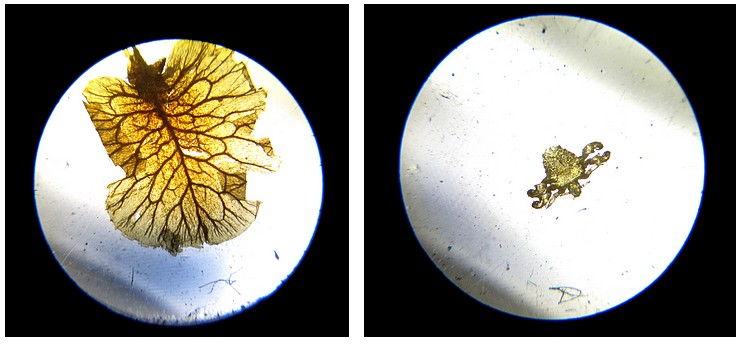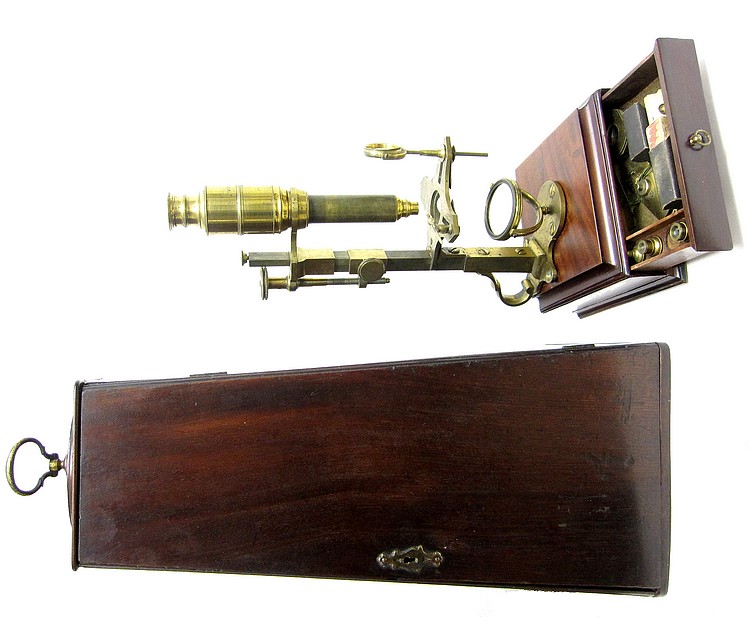
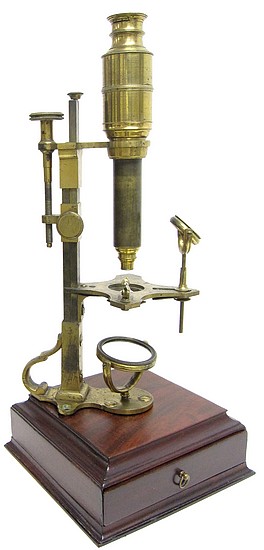
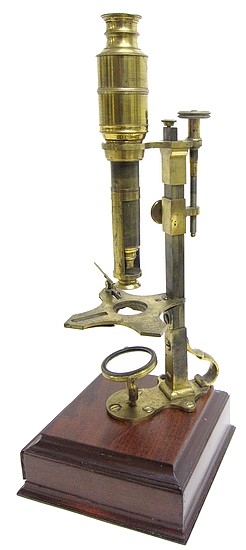
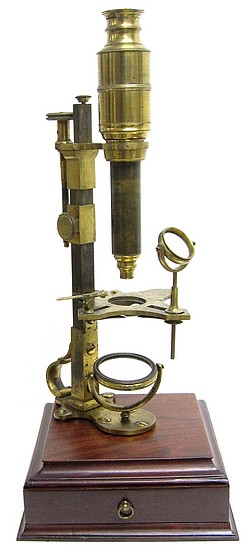
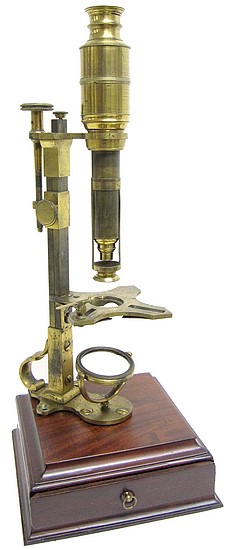
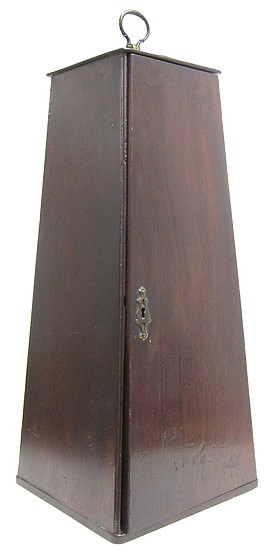
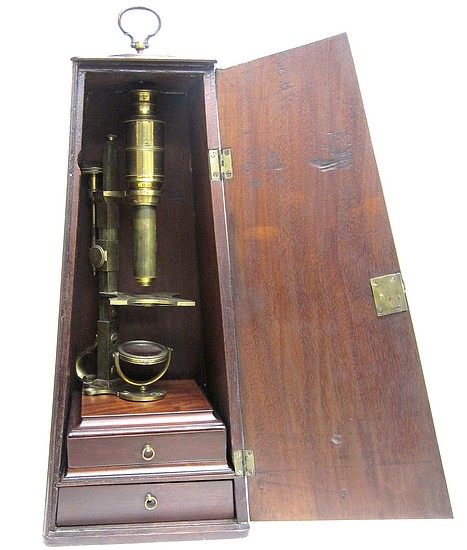
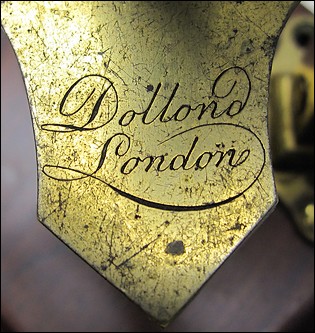
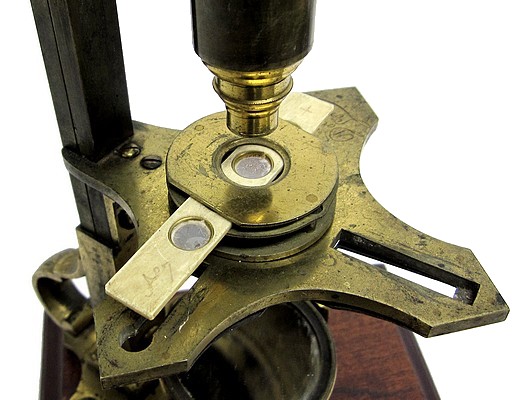
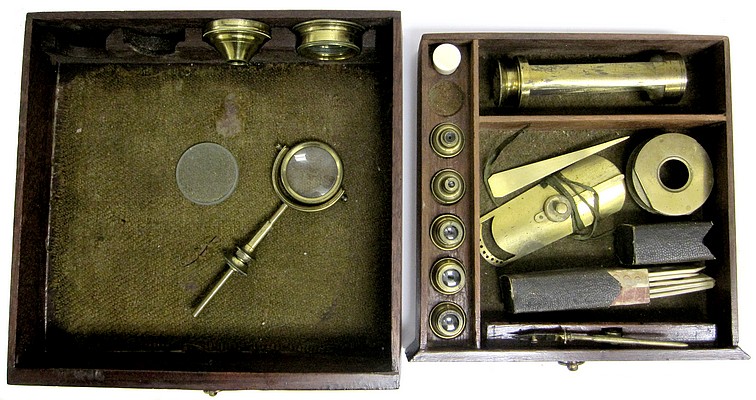
An early proponent of
the use of the microscope for scientific studies was
the naturalist Henry Baker (1698-1774). In 1743,
he published a popular work entitled The
Microscope Made Easy, which was followed in 1753
with the publication of a second work entitled
Employment for the Microscope. In two Parts.
At that time, he lamented on the fact that the
microscopes then available, primarily the Culpeper
form, were deficient both with respect to their
method of focusing and to the access that they
allowed to the stage of the microscope. This inspired
John Cuff (1708-1772), a London
instrument maker, in 1744 to come up with his own
unique design for a microscope, which was known as
Cuff's New Constructed Double Microscope . This
design allowed the stage to be freely accessible to
the hands of the user and it incorporated a fine
adjustment mechanism that allowed for more precise
focusing. This form became extremely popular and was
copied by many of the major instrument makers both in
England and on the Continent.
The particular example
in this collection was sold by Peter Dollond (1730-1820) most
likely within the 1760-1770 time frame. In most
respects, it conforms very closely to the original
Cuff design (some references have suggested that
some Cuff type microscopes signed by Dollond were
actually made by John Cuff). An identical instrument dated
1761 is in the Science Museum, London collection. The
function of the microscope and the accessories with
which it was supplied were described and illustrated
in the aforementioned 1753 Baker publication as
follows:
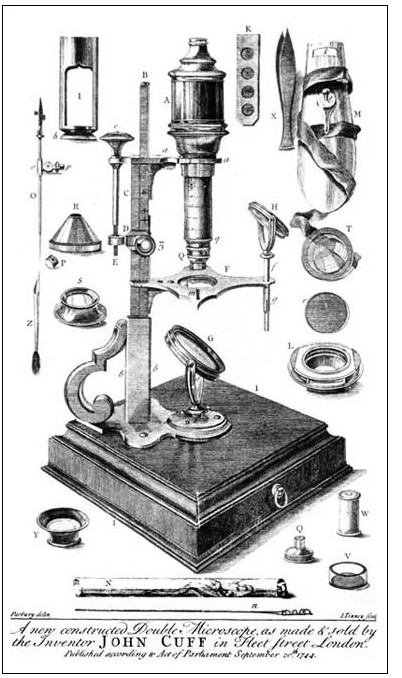
"The cumbersome and inconvenient Double Microscopes of Dr. Hook and Mr. Marshall, were many Years ago reduced to a manageable Size, improved in their Structure, supplied with an easy Way of enlightening Objects by a Speculum underneath and in many other respects rendered agreeable to the Curious, by Mr. Culpeper and Mr. Scarlet. Some farther Alterations were however wanted to make this Instrument of more general Use, as I fully experienced in the Year 1743, when examining daily the Configurations of Saline Substances, the Legs were continual Impediments to my turning about the Slips of Glass; and indeed I had found them frequently so on other Occasions Pulling the Body of the Instrument up and down was likewise subject to jerks, which caused a Difficulty in fixing it exactly at the Focus: there was also no good Contrivance for viewing opake Objects. Complaining of these Inconveniencies, Mr. Cuff, the Optician, applyed his Thoughts to fashion a Microscope in another Manner, leaving the Stage entirely free and open by taking away the Legs, applying a fine threaded Screw to regulate and adjust its Motions, and adding a concave Speculum forObjects that are opake.
The foregoing Examinations having been all made by an Instrument thus improved, I shall give a Plate and Description of it, (as an Addition to my former Book on the Microscope) by the Name of Mr. Cuffs new constructed Double Microscope.
All Parts of this Instrument are Brass. - The Body A, being firmly supported in a broad circular Collar at the End of the Arm a a, which projects from the Top of the Pillar C, may be taken out or put in at Pleasure.
A square Box b b, screwed down to the wooden Pedestal 11 supports the whole Machine by the Assistance of, the long flat-square Pillar B, which is fixed within the said Box.
The moveable Pillar
C, which is shorter than the Pillar B tho' of the
same Shape, by sliding up or down against the broad
flat Side of the said Pillar, raises or lowers the
Body of the Microscope as occasion may require. Both
Pillars stand in the Box b b.
The square Collar D
holds the two Pillars B and C together, and slides up
or down upon them, carrying with it the Body of the
Microscope. The Screw-Button 3 is intended to fix the
Pillar C, when the upper Edge of the Collar D being
set at the same Number as that of the Magnifier
employed, its focal Distance is brought nearly
right.
When the Pillar C
is fastened, the Microscope (by the fine-threaded
adjusting Screw E) may be moved so gently up or down,
without Jerks or Slips that the true Focus may be
found with great Readiness and Exactness.
The horizontal
Plate or Stage F, having in the Middle thereof a
circular Hole 4, directly over which the Body of the
Microscope is suspended, is exceedingly convenient to
place Objects on for Observation, being freed
entirely from the Legs which encumber other Double
Microscopes.
The concave Looking
Glass G, turning on two small Screws in the Arch d
(at the Bottom of which a Pin goes down into the Hole
e in the Pedestal) reflects the Light of a Candle or
the Sky directly upwards on the Object, by moving the
Looking Glass horizontally or vertically.
A double convex
Lens H, turns on two Screws, for transmitting Light
to assist in illuminating opake Objects, when the
long round Wire f is placed in the Spring-Tube g, at
the Corner of the Stage F.
I-- is a hollow
Cylinder whose sides are open, and at whose End a
concave Silver Speculum h, having a round Hole in the
Midst thereof, is screwed. This Cylinder flips over
the Snout i of the Microscope, and when set to the
Figure there marked, and correspondent to the Number
of the Magnifier made use of, the Silver Speculum
reflects Light on the opake Object to be examined;
which Object must either be held in the Spring-Tongs
at one End of the Wire O, placed in the Slit m on the
Stage F; or be put on the Ivory Block P, stuck on the
pointed End of the said Wire. The third or fourth
Magnifiers are fittest to be used with the Silver
Speculum.
K. L. M. N. QQ. R.
S. T. V. W. X. Y. Z. are different Parts of the
Apparatus which I think needless to describe, as all
who are acquainted with Microscopes will know them at
first Sight, and others may inform themselves either
in my former Treatise on these Subjects, or in the
Book which Mr. Cuff gives to those who buy this
Microscope of him."
Views through the microscope of two specimens between mica disks on an ivory slider:
